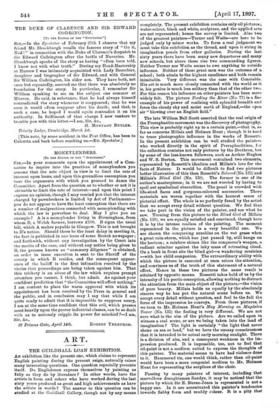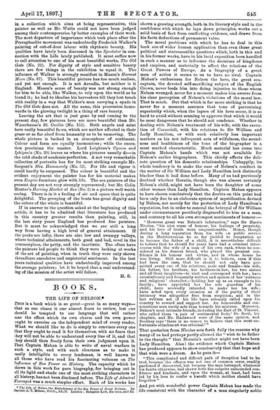ART.
TFIR GUILDHALL LOAN EXHIBITION.
Aw exhibition like the present one, which claims to represent English painting during the present reign, naturally raises many interesting questions. One question especially presents itself. Do Englishmen express themselves by painting as fully as they do by literature ? In other words, have the artists in form and colour who have worked during the last sixty years produced as great and high achievements as have the artists in words ? The answer to this question can be studied at the Guildhall Gallery, though not by any means completely. The present exhibition contains only oil pictures ; water-colour, black and white, sculpture, and the applied arts are not represented; hence the survey is limited. Also two of the greatest painters—Turner and Watts—are here to be judged only by minor works. To form a real judgment we must take this exhibition as the thread, and upon it string in imagination pearls from other galleries. During the last sixty years there have been many new departures and many new schools, but above these rise two commanding figures. Neither Turner nor Watts seems to owe anything to outside influence. Neither of these great men was the outcome of a school ; both attain to the highest excellence and both remain inimitable. Very different was the case with Constable. His art is much more closely connected with the world as it is, his genius is much less solitary than that of the other two. For this reason his influence on other painters has been more widely felt. The picture Fording the River (No. 77) is a fine example of his power of realising with splendid breadth and force the cloudy sky and moist earth of England,—the open air " blowing over an English field."
The late William Bell Scott asserted that the real origin of the Preraphaelite movement was the discovery of photography. This view is probably right up to a certain point,—that is, as far as concerns Millais and Holman Hunt ; though it is bard to trace photographic influence in the works of Rossetti. In the present exhibition can be well studied the painters who worked directly in the spirit of Preraphaelitism, for the collection contains not only pictures by the Brethren, but by some of the less-known followers, such as Arthur Hughes and W. S. Burton. This movement contained two elements, represented by Rossetti's idealism and Millais's love for the facts of Nature. It would be difficult to find two pictures better illustrative of this than Rossetti's Beloved (No.132) and Millais's Blind Girl (No. 139). The former is one of its author's masterpieces; in it we are not worried by having to• spell out symbolical obscurities. The panel is crowded with life-sized faces and gorgeous-coloured accessories. These materials are woven together with the keenest sense of pictorial effect. The whole is so perfectly fused by the artist. that we accept every detail without question. We feel thas we take part in the vision of the painter, and see what he saw. Turning from this picture to the Blind Girl of Millais (No. 139), we are equally satisfied and convinced, though here it is by the intense realism of the painting. The moment represented in the picture is a very beautiful one. We are shown the conquering sunshine on the wet grass when a great rain-storm, which has just passed by, still hangs on the horizon ; a rainbow shines like the conqueror's weapon, a radiant scimitar against the inky mass of retreating cloud. On a bank in front sits the blind girl—a wandering musician —with her child companion. The extraordinary ability with which the picture is executed at once seizes the attention, and convinces us of the truth of this statement of a natural effect. Hence in these two pictures the same result is attained by opposite means. Rossetti takes hold of us by the intensity of his poetic conception, allowing nothing to distract the attention from the main object of the picture,—the vision of pure beauty. Millais holds us equally by the absolutely sincere way he has put the natural scene before us. We accept every detail without question, and feel to the full the force of the impression he conveys. From these pictures, if we turn to Mr. Holman Hunt's May Morning on Magdalen Tower (No. 135) the feeling is very different. We are not sure what is the aim of the picture. Are we called upon to witness a real scene, or are we being taken into the land of imagination ? The light is certainly "the light that never shone on sea or land," but we have the uneasy consciousness that it is intended to be actual early morning sunlight. There is a division of aim, and a consequent weakness in the im- pression produced. It is impossible, too, not to feel that oil-paint is not a medium suited to express the thoughts of this painter. The material seems to have had violence done to it. Hammered tin, one would think, rather than oil-paint would have been a more congenial medium to Mr. Holman Hunt for representing the surplices of the choir.
Passing by many painters of interest, including that marvellous draughtsman Sandys, it may be noticed that the picture by which Sir E. Burne-Jones is represented is not a happy one. In it are accentuated this painter's tendencies towards flabby form and muddy eDlour. It is a pity that
in a collection which aims at being representative, this painter as well as Mr. Watts could not have been judged among their contemporaries by better examples of their work. The next departure of importance which took place after the Preraphaelite movement was undoubtedly Frederick Walker's painting of ont-of-door labour with rhythmic beauty. His qualities have lately been discussed in the Spectator in con- nection with the Life lately published. It must suffice now to call attention to one of his most beautiful works, The Old Gate (No. 22). For dignity of style and sensitive beauty there are few things in the exhibition to equal it. The influence of Walker is strongly manifest in Mason's Harvest Moon (No. 87). This beautiful picture has too much realism, and yet not enough. It is not Arcadia, but neither is it England. Mason's sense of beauty was not strong enough for him to be able, like Walker, to rely upon the world as he found it ; he had to idealise his harvesters till they lost touch with reality in a way that Walker's man carrying a spade in The Old Gate does not. All the same, this procession home- wards in the glowing twilight is a thing of rare beauty.
Leaving the art that is just gone by and coming to the present day, few pictures here are more beautiful than Mr. Waterhouse's St. Cecilia (No. 152). Both angels and saint have really beautiful faces, which are neither affected in their grace or so far aloof from humanity as to be unmoving. The whole picture is bathed in an atmosphere of sentiment. Colour and form are equally harmonious ; while the execu- tion proclaims the master. Lord Leighton's Cynton and Tphigenia (No. 20) leaves us where his pictures usually do—in the cold shade of academic perfection. A not very remarkable collection of portraits has for its most striking example Mr. Sargent's Mrs. Hammersly (No. 52). For life and vigour it could hardly be surpassed. The colour is beautiful and the evident enjoyment the painter has for his material makes even Empire furniture glow with life. The sea painters of the present day are not very strongly represented; but Mr. Colin Hunter's Herring Market at Sea (No. 2) is a picture well worth seeing. There is in it a feeling of air and space that is quite delightful. The grouping of the boats has great dignity and the colour of the whole is beautiful.
If in answer to the question asked at the beginning of this article, it has to be admitted that literature has produced in this country greater results than painting, still, in the last sixty years England has produced fine painters. But it must be acknowledged that we are still a long way from having a high level of general attainment. If the peaks are lofty, there are also low and swampy valleys, where technical attainments, both good and bad, revel in the commonplace, the petty, and the inartistic. Too often have the painters led people to think they were looking at works of the art of painting, when in truth they were only shown threadbare anecdotes and unpictorial sentiment. In the last years technical qualities have undoubtedly improved among the average painters; let it be hoped that a real understand- ing of the mission of the artist will follow.
H. S.



































 Previous page
Previous page